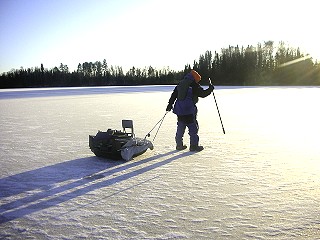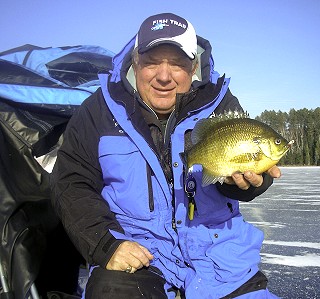| Fall weather sets up fish location at early ice. Don’t assume they’ll be where they were last year.
In today’s fast-paced world, it’s not surprising that an awful lot of ice anglers miss the clues that would lead them to fish at early ice. If you enjoy other outdoor activities (most people do), October and November are ripe with temptations. Birds of all kinds are in season. Bow hunting can chew up huge chunks of time and attention, and, of course, leads directly into gun season.
School activities pull you in several directions at once-and then there’s work, which really bites into your free time.
Under the cloud of all this confusion, the fish in your local lakes are dealt a hand of cards in the form of autumn weather, which dramatically impacts where they go (or stay) as late fall transitions to early ice.
If all you ever do is read articles about where to fish at early ice, or go back to the places that have been good to you in the past, in the words of Dave Genz, “you could hit it good or you might miss it completely.”
The older Genz gets (maybe we should say: the more experience he gains), the harder it has become for him to say anything with certainty about where fish are going to be once the ice is thick enough to support his weight. Genz never lives and dies by what happened last year at early ice-but he is very interested in what’s been going on for the past couple weeks.
“You can never assume anything,” he says, “especially if it’s based on what happened last year. Early ice is a continuation of late fall”
Fall weather, despite its reputation for being more stable than spring weather, can vary drastically across the Ice Belt. You might have an extended Indian Summer in your local area, but they might be having a nasty, windy, stormy, cold fall in other regions.
Or, vice versa.
“It all depends on the conditions in the weeks leading to ice-up,” says Genz. “If you get a period of calm weather with lots of sunshine, that can start the weeds growing in the shallow water again. The weeds might die and lay down when the first cold fall weather comes, then here comes this nice weather and they start growing again. Bug hatches can occur in the shallows if the weather is warm, too, and that can make fish stay shallower.”
If there is life in the shallows right before freeze-up, that life will still be there after the ice gets thick enough to fish through. “It’s a chain reaction,” says Genz. “If the bluegills are in there, that brings in the walleyes, pike and bass.”
By no means is he suggesting that every fish in the lake will be shallow, even under the mildest late fall/early ice conditions. “But there can be a lot of fish shallow,” says Genz, “and they can stay shallow well into the winter, if the weeds are healthy and there’s food in there.”
As an early-ice angler, should you expect to find fish shallow, or deep?
 |
| Venturing onto early ice means wearing a life jacket and using a chisel to test ice thickness ahead of where you are about to step. Be careful, but remember that the reward can be great action from unpressured fish that are feeding throughout the day. |
The safest bet is to look shallow first, carefully checking the condition of any shallow weeds. If they look healthy, suspect shallow fish.
“But if we have one of those nasty falls,” says Dave, “where it’s rainy, cloudy, snowy, windy, you’re more likely to find most of the fish deeper right away.”
Movements fish make in response to late fall weather patterns, in Genz’s experience, are often short in distance, but they almost always involve a change of depth. He says fish often show a distinct tendency to settle into a general depth level, which you can determine by fishing.
Check classic spots (we’ll list some in a minute) at early ice, but if they don’t produce, look elsewhere. Chances are, the fish won’t be far, but they might be shallower or deeper than you originally guessed.
Because you can fish more efficiently in shallow water, check shallow spots first. Pay close attention to the condition of shallow weeds or other cover. If fish don’t seem to be shallow, then work your way deeper, a little at a time. “It’s not against the rules to drill holes,” jokes Genz. “The new Strikemaster augers let me drill as many holes as I need, with minimal effort. It takes time to find the fish on a lot of days, but that search is part of the fun.”
Be Quiet, Expect Biters
At early ice, the sun hangs low in the sky from daybreak to sunset, so the morning bite extends into the evening bite. It’s all prime time, assuming you can get on the fish.
Stealth is a huge factor, because thin, clear ice tends to magnify movements and noises. Careless walking, scraping and cutting will send fish scattering before you can show them a bait. But if you are quiet and offer them something that looks right, early ice fishing can be one of the best periods of the year.
For one thing, fish have not been bothered much in the recent past by boating or fishing pressure. Few boats venture out in the gray of late fall. And as ice conditions become ‘walkable,’ many anglers are reluctant to be first to shuffle across the groaning, cracking surface.
Not Genz. He straps on a life jacket, grabs the chisel, and checks the ice as he walks, knowing that the fish are looking to feed throughout the shrinking daylight hours.
 |
| Here’s Dave Genz with a dandy bluegill caught at first ice. Early winter fish are in the mood to eat, but you have to be stealthy in your approach to avoid spooking them. |
“That’s the game at first ice,” says Genz, “The fish are out there cruising around, and they want to eat. But you can’t spook ’em.”
Classic Early Ice Spots
Here is a list of high-percentage early-ice locations for many fish species. Whether you find the fish shallow or deeper in these spots becomes the essence of the hunt.
Current areas
Wherever creeks run into the lakes, or you find necked-down narrows. Because lake levels are not typically ‘spring runoff’ high, the current is not roaring, but rather just moving along, breathing life into the system. Calling fish.
“This is a good walleye spot,” says Genz. “It’s the same spot you would wade and cast for walleyes right before the ice comes. You have to use caution, because you might have thin ice, or thin patches. But we’re not talking about fast current.”
Sh allow and mid-depth bays
“Like the spring spots you fish in the boat,” says Genz. “Bays on the north end of the lake, spots with southern exposure, where the sun can warm the water during the day.”
Deep water close to shore
Anywhere deeper water “cuts close to the shoreline,” says Genz, gets his heart racing. “When I’m looking at a lake map, I look for spots like this on the north and west side of the lake. Again, it’s due to the warming of the sun. Where an inside turn cuts into the shoreline. Fish the places where the deepest water is closest to the shore.”
Fish can sometimes be found in such places all winter, “but fish it shallower at early ice,” says Genz. “At midwinter, I might start in the deepest part. But early, I might start as shallow as a cattail bank, where the deep water runs close to it.”
So, if anything, the search tends to go shallower at early ice. But not after a nasty spell of late fall weather has choked the life out of shallow water.
Deep holes in bowls
In relatively structureless ‘bowl’ type lakes, suspect that most fish settle into deeper holes by the time ice forms. ‘Deeper’ can be a relative term, because this type of lake might have little in the way of overall depth.
“Deep can be 10 or 12 feet a lot of times,” says Genz. “In those bowl-type lakes, a lot of fish set up in the middle of the lake right away and spend the whole winter there.”
The bottom line on early ice?
Even if you have had good success in certain spots in the past, be careful about banking on them. Don’t assume much of anything. Pay close attention to late fall weather trends, and let that information help you guess where most of the fish might be, this year, when the ice forms.
Then, get out there and see if the fish are where you think they are. If not, keep looking, until you find where they’ve gone, in reaction to the late fall weather.
Dave Genz, known as Mr. Ice Fishing, was the primary driver of the modern ice fishing revolution. |